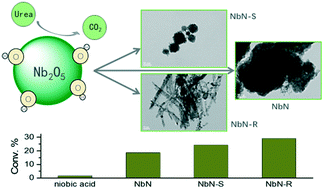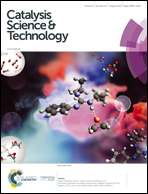Morphology-maintaining synthesis of NbN and its catalytic performance in epoxidation†
Abstract
NbN materials have a wide range of applications in the fields of catalysis and semiconductors, due to their unique chemical and physical properties. However, only a few reports focused on the synthesis of NbN materials with different morphologies due to their harsh nitridation conditions. Herein, we successfully prepared amorphous NbN, spherical NbN (NbN-S) and nanobelt NbN (NbN-B) from different niobium precursors with corresponding morphologies by using urea as a nitrogen source at 750 °C. Comprehensive characterization (including XRD, N2 sorption measurements, ICP-AES, FTIR spectroscopy, TG analysis, SEM, TEM, X-ray photoelectron spectroscopy (XPS), and X-ray absorption spectroscopy (XAS)) revealed the formation of NbN and the structural information of these NbN materials. Based on these characterizations, we found that the amount of surface Nb–OH groups is an important factor for successful nitridation under mild conditions. Moreover, the synthesized NbN materials can be used in the epoxidation of cyclooctene and a very high epoxycyclooctane yield (93.9%) was achieved, which is much higher than that over the corresponding Nb2O5 materials. This excellent catalytic performance of NbN materials is supposedly related to the low-coordinated Nb sites and rich vacancies generated during the special nitridation process.



 Please wait while we load your content...
Please wait while we load your content...